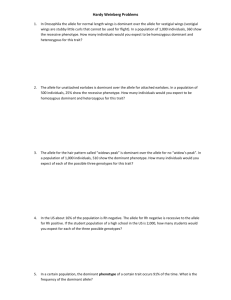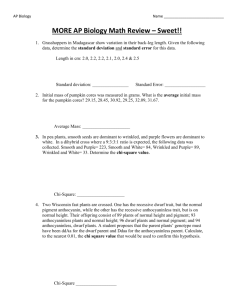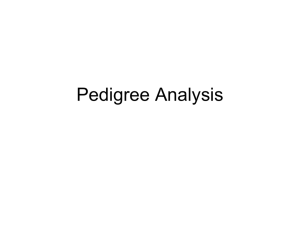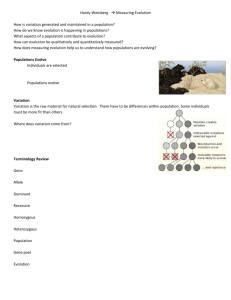Final Review - LangdonBiology.org
advertisement
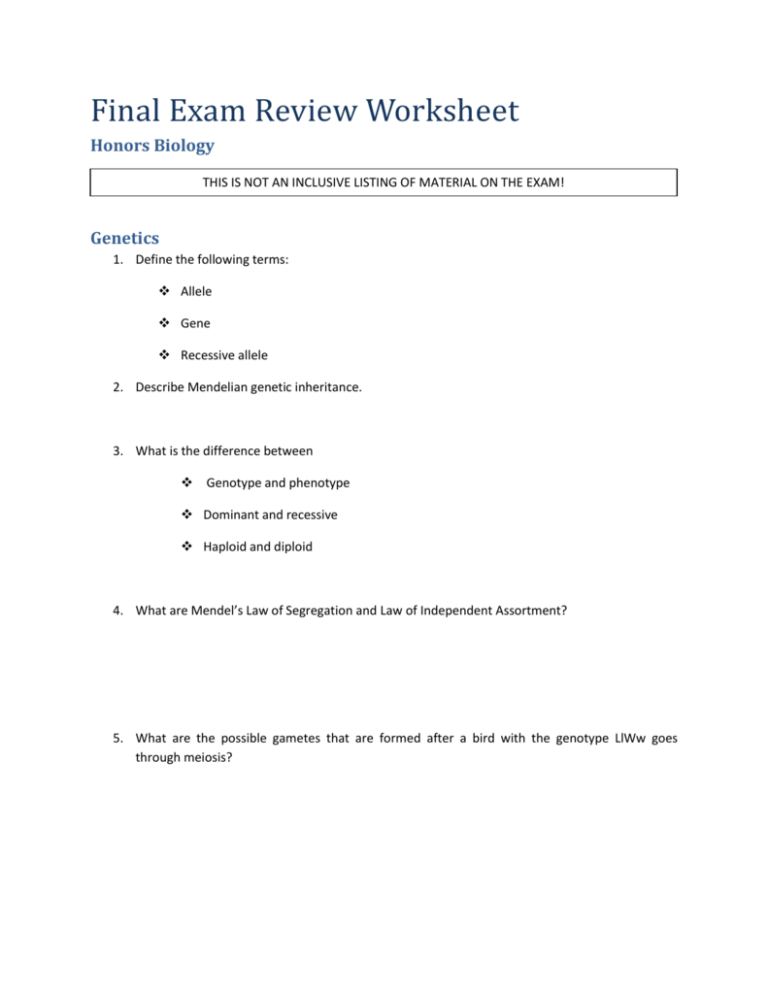
Final Exam Review Worksheet Honors Biology THIS IS NOT AN INCLUSIVE LISTING OF MATERIAL ON THE EXAM! Genetics 1. Define the following terms: Allele Gene Recessive allele 2. Describe Mendelian genetic inheritance. 3. What is the difference between Genotype and phenotype Dominant and recessive Haploid and diploid 4. What are Mendel’s Law of Segregation and Law of Independent Assortment? 5. What are the possible gametes that are formed after a bird with the genotype LlWw goes through meiosis? 6. In a certain species of plant, yellow flowers (F) are dominant to blue flowers, and three leaf clusters (L) are dominant to two leaf clusters. You mate two dihybrids together. What percentage of the offspring would you expect to have yellow flowers and three leaves? What percentage would have blue flowers and two leaves? 7. Describe the following inheritance patterns: Lizards come in a wide range of colors, from pale green to very dark green and every shade in between. A species of platyhelminthes has been found that has either brown stripes, black stripes, or both black and brown stripes simultaneously. You discover that male gerbils suffer from a respiratory disease far more than female gerbils do. Biotechnology 8. What are the following biotech tools used for? Electrophoresis PCR Plasmids Evolution 9. Describe Charles Darwin’s Theory of Natural Selection. 10. Briefly summarize the following lines of evidence that support Darwin’s theory Artificial Selection Fossil Evidence Homologous Structures & Vestigial Structures Protein and DNA Similarities 11. What is the modern, molecular definition of evolution? 12. Genetic drift is evolution, but not natural selection. Define genetic drift, and give two common forms of genetic drift. 13. You analyze the gene pool of a certain organism. You find that the dominant allele makes up 78% of the pool. What is the recessive allele frequency? How many heterozygotes would you expect? 14. You are studying a population of songbirds. You find that 27% of the population is homozygous dominant for a particular trait. What are the dominant and recessive allele frequencies? What percentage of the birds would you expect to be homozygous recessive? 15. Describe directional, stabilizing, and disruptive selection. 16. Some of the most pronounced evolutionary changes are those that lead to speciation. What is speciation? 17. What is the difference between allopatric and sympatric speciation? 18. Briefly describe how sympatric speciation can occur. 19. What is sexual selection? How does it relate to natural selection? 20. There are two theories that describe exactly how organisms can change over time: gradualism and punctuated equilibrium. Describe them. Evolution of Life on Earth 21. How old is the Earth? When did life first appear? 22. What do we believe the earliest life forms were like? 23. What role did oxygen play in the evolution of life? Classification 24. List the taxa of the modern phylogenic scheme from most general to most specific. Domains Bacteria and Archea 25. What are the defining characteristics of members of Domain Bacteria and those of Domain Archea? 26. Bacteria that cause disease often have capsules, pili, and flagella. What are they used for? 27. Describe some of the special environments Archea can be found in. Viruses and Prions 28. What is the difference between the lytic and lysogenic cycles? 29. What is a retrovirus? What is reverse transcriptase used for? 30. Why are viral infections so difficult to treat? What are vaccines? 31. What is prion? What is a notorious condition it causes? Protists 32. What is the formal definition of a protist? 33. List and describe the three major groups of protists. 34. Why are massive groups of cells, like Volvox, classified as protists? 35. What are some of the evolutionary advances made by protists over the prokarya? Fungi 36. What is the formal definition of a fungus? 37. What role do the fungi play in the environment? 38. Describe the reproductive cycle of a common fungus. Pay attention to the haploid and diploid stages. 39. What are the evolutionary advances of fungi over protists? Plants 40. What is formal definition of a plant? 41. Describe the evolutionary changes of bryophytes to tracheophytes (pteropsides) to gymnosperms to angiosperms. 42. Tell how to differentiate between the two classes of angiosperms: the monocots and the dicots. 43. Describe the circulatory system of a plant. 44. Give the plant hormones and list their function. 45. Describe photo-, gravito-, and thigmotropism. 46. Draw the structure of a leaf cross section, and give the role of the parts. 47. Describe the double fertilization of angiosperms. Pay attention to the diploid and haploid stages. Ecology 48. Describe the levels of ecological organization, from the single organism to the entire planet. 49. Draw and then explain the relevant parts of a typical population curve. 50. What is ecological succession? How does primary and secondary succession differ? 51. Describe three types of symbioses. 52. Be able to discuss chemical cycles in nature, particularly the carbon-oxygen and the nitrogen cycle. 53. Know all the biomes. Human Systems 54. Skeletal system. Sketch a long bone, like the femur. Label the cartilage cap, the marrow, the spongy bone, the compact bone, Haversian canals, and the periosteum. What are the roles of tendons and ligaments? 55. Muscle system. What are the three types of muscles found in the human body? Sketch a sarcomere from a skeletal muscle. Be able to describe at the molecular level what happens when a muscle contracts 56. Circulatory System. Describe the components of human blood. Label the structures of the human heart. Atria Ventricles Septum Aorta Pulmonary arteries SA Node AV Node Purkinje Fibers Sketch in the inferior and superior vena cava and pulmonary veins. Explain how electrical signals control a heartbeat. Sketch an EKG strip. Show the contraction of atria, ventricles, and repolarization of the ventricles. 57. Respiratory System. Label the structures in the respiratory tract. Describe the process of breathing. 58. Excretory system. Label the kidneys, ureters, bladder, and urethra. Label the structures of the nephron: capsule, Loop of Henle, collecting duct. the glomerulus, Bowman’s Describe how water is reclaimed in the human kidney. 59. Digestive system. Label the organs of the digestive tract. Describe where the following biomolecules are digested: Carbohydrates Lipids Proteins Nucleic Acids Where are nutrients absorbed? What is the role of the large intestine? 60. Describe the three basic types of neurons. 61. Describe a reflex arc. 62. Describe the three basic parts of the human brain. 63. Why do the lungs have alveoli, the blood vessels have capillaries, the intestines have villi, the brain have folds, the neurons have dendrites, the kidneys have nephrons, etc?



